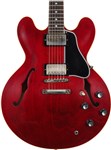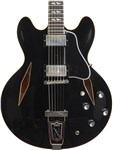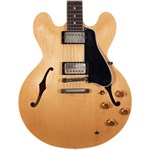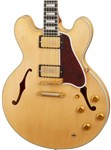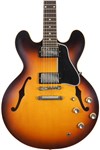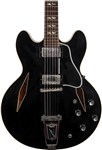Gibson Custom L-4 CES Mahogany, Vintage Sunburst Overview
Gibson Custom L-4 CES Mahogany Overview by GAK:
The Gibson L-4 archtop became jazz’s greatest rhythm instrument in the 1920s and assured the company’s dominance of the guitar market even before the outbreak of World War I. But the L-4’s story - how it evolved from an acoustic guitar to the dynamic L-4 CES Mahogany Archtop of today - is perhaps the best illustration of Gibson’s historic dedication to endlessly refining and improving instruments that are already world class.The L-4 was developed as a louder, bolder update of Gibson’s popular L-1 and L-3 designs, advertised as a “grand concert size” model with 20 frets, one more than its predecessors. The L-4’s top changed radically in 1935 when, under the direction of the company’s famed designer Lloyd Loar, the round sound hole was replaced by a pair of f-holes to enhance tone and projection. During the ‘40s, many elements were added including crown pegheads and parallelogram inlays on its fingerboard, but the biggest innovation in the guitar’s design came in 1949 with electrification.
To meet the demands of the dawn of popular music’s electric age, Gibson first created the laminated top ES-175 in 1948 based on the construction of the acoustic carved top L-4. But players still wanted a genuine electric full-bodied L-4 with a carved top. The first wave of these guitars were built in small batches throughout the 1950s, but were perfected late in the decade. Along the way the guitar’s body traded its rounded edges for a single cutaway horn to allow easier access to the high notes – a sign of the L-4’s evolution from rhythm to lead-and-rhythm instrument. Finally, in 1958, the design reached a pinnacle with a run of 20 guitars bearing the Gibson L-4 CES name. Some had Charlie Christian pickups, others Alnicos, and a few sported humbuckers. Over time the humbuckers proved the most versatile and practical, and thus today’s graceful mahogany L-4 CES model reached maturity.
Today’s gorgeous L-4 CES six-strings still adhere to the classic design of their namesakes. They have a solid carved spruce top and a carved solid mahogany back and rims. They are a comfortable 16-inches wide, 20-inches long, and 3 3/8th-inches deep and comes with multi-ply white or black binding on top, with single ply white binding on their backs. Contributing much to the guitar’s silky, lush, deep tone is the one-piece mahogany neck. It has a 24 ¾ inch scale length and is 1 11/16-inches wide at the nut. True to the model’s historic evolution, today’s L-4 CES has a 20 fret rosewood fretboard with pearl split parallelogram inlays and single ply white binding. It boasts the classic ES rounded profile and a headstock with vintage tulip shape tuners.
Featuring attractive gold hardware, the electronics and controls are pure Gibson: two ’57 Classic humbucking pickups, two volume pots, two tone pots, and a 3-way pickup selector switch. The tailpiece is the iconic L-4 T-shape style and the bridge a hard working ABR-1. The L-4 CES, after being examined and set up on Gibson’s state-of-the-art Plek machines, is shipped wearing L-5 Electric .012 strings. These marvellous guitars come with a Custom Shop case and certificate of authenticity. But the real proof is in their great tone and style.
- Solid Spruce Top
- Solid Mahogany Back and Sides
- One-Piece Mahogany Neck
- 1-11/16” Nut Width
- Indian Rosewood Fretboard
- 20 Frets
- Pearl Parallelogram Inlays
- ES Rounded Neck Profile
- Gold Hardware
- '57 Classic Humbuckers
- ABR-1 Bridge
- L-4 Tailpiece
- 24-3/4” Scale Length
- 16" Body Width
- 20" Body Length
- 3-3/8" Body Depth












































